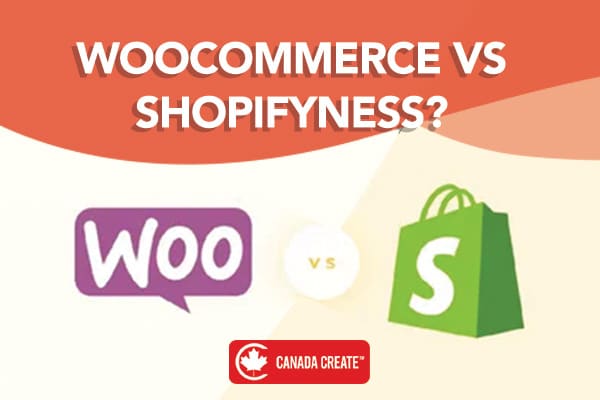Are you in doubt about WooCommerce Vs. Shopify for your eCommerce business? Choosing the right platform is crucial for the success of your online store. In this extensive comparison, we will explore the key differences and advantages of WooCommerce and Shopify. By examining factors such as ease of use, customization options, pricing, and scalability, you will gain insights to help you make an informed decision. Whether you prioritize flexibility and control or seek simplicity and convenience, this guide will assist you in determining which eCommerce platform is best suited for your business needs.
WooCommerce vs. Shopify: At a Glance
Aspect | WooCommerce | Shopify |
| Platform Type | WordPress plugin | Hosted Platform |
| Ease of Use | May require more technical knowledge | Beginner-friendly |
| Setup | Requires hosting, domain, and WordPress | Fully hosted solution |
| Customization | Highly customizable with themes and plugins | Limited customization compared to WooCommerce |
| Themes | Plenty of WordPress themes are available | Extensive theme selection |
| Transaction Fees | No additional fees (except payment gateways) | Transaction fees apply (unless using Shopify Payments) |
| Payment Gateways | Supports various gateways, flexible options | A wide range of payment gateways supported |
| Security | Depends on hosting and WordPress security | Hosted on Shopify’s secure servers |
| Scalability | Scales well with the appropriate hosting | Built for scalability, suitable for large stores |
| Extensions and Apps | Extensive WordPress plugins are available | Shopify App Store offers many apps and integrations |
| SEO Friendliness | Good SEO capabilities with WordPress SEO plugins | Built-in SEO features |
| Costs | Variable depends on hosting and plugins | Monthly subscription fees, transaction fees |
| Hosting | Self-hosted (additional cost) or managed hosting | Hosted by Shopify, included in subscription |
| Support | Community support and documentation | 24/7 customer support |
| Updates and Maintenance | Requires regular updates for WordPress, plugins | Handled by Shopify, automatic updates |
| Ownership | Full ownership of data and site | Some restrictions on data and customization |
| Popularity | Widely used, especially with WordPress websites | Popular and widely used eCommerce platform |
Set Up and User Experience (UX)
WooCommerce
When it comes to Set Up and User Experience (UX), WooCommerce and Shopify offer different approaches. WooCommerce requires a self-hosted WordPress installation, which may require some technical knowledge to set up and configure. Additionally, it offers more flexibility and customization options, allowing users to tailor their online store to specific needs. However, regular updates and maintenance are necessary for optimal performance.
Shopify
On the other hand, Shopify is a hosted solution, eliminating the need for separate hosting. Its setup process is user-friendly, with guided instructions to help users get started quickly. While customization options may be more limited compared to WooCommerce, Shopify provides an intuitive and visually appealing interface. It also offers hassle-free updates and maintenance.
Ultimately, the choice between WooCommerce Vs. Shopify depends on the user’s technical expertise and preference for flexibility or simplicity in their online store setup and user experience.
Looking for web design in Toronto? Check our services and package pricing before you decide!
WooCommerce Vs. Shopify: Designs and Themes
WooCommerce
When it comes to Designs and Themes, both WooCommerce and Shopify offer a range of options to create an aesthetically pleasing online store. WooCommerce, being built on WordPress, provides access to a vast library of themes and plugins, giving you the freedom to customize your store’s design to your heart’s content. This flexibility allows you to create a unique and tailored look that aligns with your brand identity.
Shopify
It offers a curated selection of themes that are designed to be visually appealing and user-friendly. While the number of themes may be more limited compared to WooCommerce, Shopify ensures that each option is optimized for a seamless user experience.
Whether you prioritize extensive customization options or prefer a curated and visually appealing design, both platforms have their strengths in providing a visually stunning and user-friendly storefront for your online business.
Costs
WooCommerce
WooCommerce itself is a free plugin for WordPress, which means you can set up and use the platform without any upfront costs. However, it’s important to note that you will still need to pay for other essentials such as web hosting, domain registration, and SSL certificates. Additionally, if you opt for premium themes or extensions, there may be additional costs involved.
Shopify
On the other hand, Shopify operates on a subscription model, with different pricing tiers based on your business needs. While Shopify does have a monthly fee, it includes hosting, security, and technical support in the package. Shopify also offers a wide range of premium themes and apps, which may come with additional costs.
Finally, the cost comparison between WooCommerce Vs. Shopify depends on factors such as the size of your business, desired features, and customization requirements. It’s important to evaluate your budget and consider the long-term costs associated with both platforms before making a decision.
Wondering How to Choose the Right Type of Website for Your Business? Reading this article will give you a better understanding of the factors to consider when choosing a website for your business.
Support
WooCommerce being a free plugin for WordPress, relies on a community-driven support system. There are numerous online forums, documentation, and tutorials available where users can find solutions to their queries. Additionally, some third-party developers and agencies offer support services for WooCommerce.
Shopify provides 24/7 customer support through various channels, including live chat, email, and phone. Shopify’s support team is known for their prompt and knowledgeable responses, making it easier for users to get assistance when needed. Furthermore, Shopify offers a comprehensive help center and a vast knowledge base to address common issues and provide self-help resources.
Overall, while WooCommerce relies more on community support, Shopify offers a more direct and dedicated support system for its users.
SEO
WooCommerce, being built on WordPress, provides a solid foundation for SEO. It offers a wide range of SEO plugins and extensions that allow you to optimize your website’s meta tags, URLs, sitemaps, and more. With WooCommerce, you have full control over your SEO strategy and can implement advanced SEO techniques.
Shopify also provides built-in SEO features. It automatically generates SEO-friendly URLs, allows you to customize meta tags, and provides options for adding alt tags to images. Additionally, Shopify offers a range of SEO apps that can further enhance your store’s optimization.
When in doubt about WooCommerce Vs. Shopify, it is worth mentioning that both platforms offer SEO capabilities, WooCommerce provides more flexibility for advanced SEO practices, while Shopify offers a user-friendly and intuitive approach to on-page optimization.
How Does Shopify Approach E-commerce?
Shopify approaches e-commerce by providing a comprehensive platform that simplifies the process of setting up and running an online store. With Shopify, users can easily create and customize their store’s design, manage products and inventory, process payments, and handle shipping and fulfillment. The platform offers a user-friendly interface and intuitive tools, making it accessible to both beginners and experienced e-commerce entrepreneurs.
Shopify also provides a range of features and functionalities to enhance the online shopping experience, such as abandoned cart recovery, discount codes, and customer reviews. Additionally, Shopify offers a wide selection of themes and apps to customize and expand the functionality of your store. With its emphasis on user experience, reliability, and scalability, Shopify empowers businesses of all sizes to succeed in the world of e-commerce.
How Does WooCommerce Approach E-commerce?
WooCommerce approaches e-commerce by providing a flexible and customizable solution for building online stores. As a plugin for WordPress, WooCommerce seamlessly integrates with the WordPress platform, allowing users to leverage its extensive features and capabilities. With WooCommerce, users can easily set up their online store, manage products, handle inventory, process payments, and handle shipping and tax calculations. The platform offers a wide range of themes and extensions, enabling users to customize the design and functionality of their store to meet their specific needs. Additionally, WooCommerce provides a robust ecosystem of third-party plugins and integrations, allowing users to expand the capabilities of their store as their business grows. With its focus on flexibility, customization, and integration, WooCommerce empowers businesses to create unique and tailored e-commerce experiences for their customers.
WooCommerce Vs. Shopify: What Are the Pros and Cons of Each Platform?
WooCommerce
Pros | Cons |
| High customization with plugins and themes | May require more technical knowledge |
| No transaction fees (except payment gateways) | Hosting costs and domain required |
| Extensive plugin ecosystem | More customization may need coding skills |
| Supports various gateways, flexible options | Depends on hosting and WordPress security |
| Full ownership of data and site | Requires regular updates for WordPress, plugins |
| Good SEO capabilities with plugins | Requires more responsibility for security and updates |
Shopify
Pros | Cons |
| User-friendly interface | Limited flexibility for advanced users |
| All-inclusive plans simplify cost structure | Transaction fees (unless using Shopify Payments) |
| Built for scalability, suitable for growth | Limited compared to WooCommerce |
| Shopify App Store offers many integrations | Hosted solution may be perceived as safer |
| 24/7 customer support | Updates are automatic, and less maintenance |
| Extensive theme selection | Less control over hosting and infrastructure |
Wrap-Up: WooCommerce vs. Shopify
Choosing between WooCommerce and Shopify ultimately depends on your specific needs and preferences as an e-commerce business owner. Consider factors such as your budget, technical expertise, desired level of customization, and long-term scalability when making your decision. By carefully evaluating your specific requirements, you can choose the platform that best aligns with your business goals and sets you up for e-commerce success.
FAQs
- Is Shopify safer than WooCommerce?
When in doubt about WooCommerce Vs. Shopify, both platforms prioritize security, so they offer similar levels of safety.
- Is Shopify more expensive than WooCommerce?
Shopify has a subscription fee, while WooCommerce itself is free, but overall costs depend on individual needs.
- Is Shopify harder than WordPress?
Shopify is generally considered easier to use than WordPress, but it depends on individual familiarity and preferences.
- Is WooCommerce actually free?
WooCommerce itself is free, but additional costs may be incurred for hosting, domain, and premium extensions or themes.






